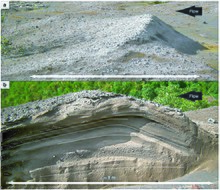Effects of the storage conditions on the stability of natural and synthetic cannabis in biological matrices for forensic toxicology analysis: An update from the literature
Contents
A pyroclastic surge is a fluidised mass of turbulent gas and rock fragments that is ejected during some volcanic eruptions. It is similar to a pyroclastic flow but it has a lower density or contains a much higher ratio of gas to rock,[1] which makes it more turbulent and allows it to rise over ridges and hills rather than always travel downhill as pyroclastic flows do.
The speed of pyroclastic density currents has been measured directly via photography only in the case of Mount St. Helens, where they reached 320-470 km/h, or 90–130 m/s (200–290 mph). Estimates of other modern eruptions are around 360 km/h, or 100 m/s (225 mph).[2] Pyroclastic flows may generate surges. For example, the city of Saint-Pierre in Martinique in 1902 was overcome by one. Pyroclastic surge include 3 types, which are base surge, ash-cloud surge, and ground surge.
Base surge
Base surges were first recognized after the Taal Volcano eruption of 1965 in the Philippines, where a visiting volcanologist from USGS recognized the phenomenon as congruent to base surge in nuclear explosions.[3] Very similar to the ground-hugging blasts associated with nuclear explosions, these surges are expanding rings of a turbulent mixture of fragments and gas that surge outward at the base of explosion columns. Base surges are more likely generated by the interaction of magma and water or phreatomagmatic eruptions.[4] They develop from the interaction of magma (often basaltic) and water to form thin wedge-shaped deposits characteristic of maars.[5]
Ash-cloud surge
These are the most devastating. They form thin deposits, but travel at great speed (10–100 m/s) carrying abundant debris such as trees, rocks, bricks, tiles, etc. They are so powerful that they often blast and erode material (like sandblasting). They are possibly produced when conditions in an eruption column are close to the boundary conditions separating convection from collapse. That is, switching rapidly from one condition to the other.[5]
Ground surge
These deposits are often found at the base of pyroclastic flows. They are thinly bedded, laminated and often cross-bedded.[6] Typically they are about 1 m. thick and consist mostly of lithic and crystal fragments (fine ash elutriated away). They appear to form from the flow itself, but the mechanism is not clear. One possibility is that the head of the flow expands through entrainment of air (which is then heated). This then results in the flow front surging forward, which is then over-run by the rest of the flow.[5]

See also
References
- ^ "Glossary of Volcano and Related Terminology". USGS Cascades Volcano Observatory. Retrieved on 2011-04-23.
- ^ Belousov, Alexander; Voight, Barry; Belousova, Marina (2007). "Directed blasts and blast-generated pyroclastic density currents: a comparison of the Bezymianny 1956, Mount St Helens 1980, and Soufrière Hills, Montserrat 1997 eruptions and deposits". Bulletin of Volcanology. 69 (7). Springer Verlag: 701–740. Bibcode:2007BVol...69..701B. doi:10.1007/s00445-006-0109-y. S2CID 53540720. Retrieved 8 September 2012.
- ^ See:
- Moore, James G. (1967) "Base surge in recent volcanic eruptions", Bulletin Volcanologique, 2nd series, 30 : 337–363.
- Cas, R.A.F and Wright, J.V., Volcanic Successions Modern and Ancient: A geological approach to processes, products and successions (London, England: Chapman & Hall, 1988), p. 114.
- ^ Becker, Robert John, and Becker, Barbara (1998). "Volcanoes", p.133. J.H. Freeman and Company, US. ISBN 0-7167-2440-5.
- ^ a b c Riley, CM. "Pyroclastic Flows and Surges" (PDF). Retrieved 10 August 2022.
- ^ a b Douillet, Guilhem Amin; Pacheco, Daniel Alejandro; Kueppers, Ulrich; Letort, Jean; Tsang-Hin-Sun, Ève; Bustillos, Jorge; Hall, Minard; Ramón, Patricio; Dingwell, Donald B. (2013-10-13). "Dune bedforms produced by dilute pyroclastic density currents from the August 2006 eruption of Tungurahua volcano, Ecuador". Bulletin of Volcanology. 75 (11): 762. doi:10.1007/s00445-013-0762-x. ISSN 1432-0819. PMC 4456068. PMID 26069385.


















